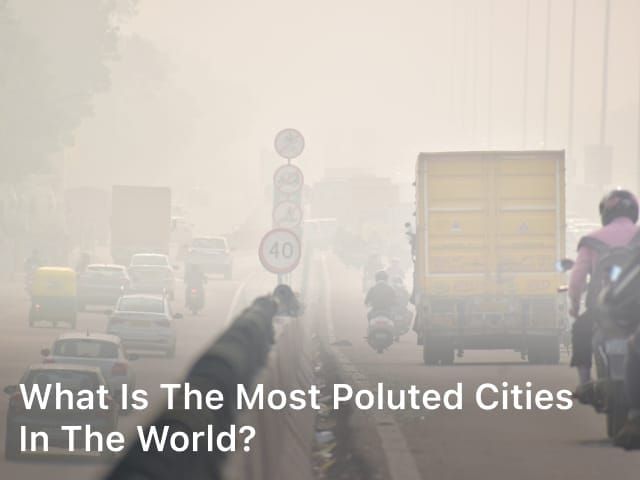ecowarriornation.com. What is The Most Poluted Cities in The World? – Discover a comprehensive list of the Most Poluted Cities in The World. Inform yourself about these pollution hotspots and the environmental challenges they face.
Table of Contents
ToggleWhat are the Most Poluted Cities in The World?
Urban areas around the world are grappling with the challenges of environmental pollution. Among these challenges are high levels of air, water, and soil pollution.
The World Health Organization (WHO) estimates that about 7 million people die every year due to exposure to polluted air. This article focuses on the most polluted cities in the world and the environmental challenges they face.
Key Takeaways:
- The world is facing environmental pollution challenges, especially in urban areas.
- Exposure to polluted air can lead to respiratory problems, cardiovascular diseases, and other related health issues.
- The article will provide a ranking of the most polluted cities in the world using data from reputable sources such as the WHO and EPI.
- The article will also highlight the efforts being undertaken to combat pollution in urban areas and provide a future outlook on pollution control.
Factors Contributing to Pollution in Urban Areas
Urban areas are home to a majority of the world’s population and are hubs of economic and industrial activity. However, this high concentration of people and industries also means that urban areas are major sources of pollution. Here are some of the key factors contributing to pollution in urban areas:
| Industrial Emissions | Industries such as factories and power plants emit large amounts of pollutants such as particulate matter, sulfur dioxide, and nitrogen oxides into the air. |
|---|---|
| Traffic Congestion | The high volume of vehicles on urban roads leads to increased emissions of greenhouse gases and other pollutants such as carbon monoxide and volatile organic compounds. |
| Population Density | The high concentration of people in urban areas means that there is more demand for energy and resources, leading to increased pollution from power generation, transportation, and waste disposal. |
| Poor Waste Management | The improper handling and disposal of waste in urban areas can lead to the release of pollutants into the air, water, and soil. |
These factors, combined with a lack of effective pollution control measures, have resulted in the high levels of pollution seen in many urban areas around the world.
The Impact of Air Pollution on Human Health
Air pollution is a serious environmental challenge faced by many urban areas around the world. The rise of industrialization and urbanization has led to an increase in pollutants in the air, causing a range of health problems for those who breathe it in. The impact of air pollution on human health cannot be ignored.
The World Health Organization (WHO) estimates that air pollution kills about 7 million people worldwide every year. The most vulnerable groups are children, the elderly, and those with pre-existing health conditions.
Air pollution can cause respiratory problems, such as asthma, chronic obstructive pulmonary disease (COPD), and lung cancer. It can also result in cardiovascular diseases, such as stroke and heart disease. The impact of air pollution on human health is not limited to these conditions, as it can also lead to neurological and reproductive problems.
The severity of the health impact depends on the duration and intensity of exposure. In heavily polluted cities, residents are exposed to high levels of particulate matter, nitrogen oxides, and other harmful pollutants on a daily basis, increasing their risk of developing health problems. The impact of air pollution on human health is a major concern for policymakers and public health officials, and efforts are being made to reduce pollution levels and protect public health.
Ranking the Most Polluted Cities in the World
When it comes to pollution, some cities in the world stand out as the most affected. These cities experience high levels of air and water pollution, which pose a significant threat to the health of their inhabitants and the environment. Here is a list of the 10 most polluted cities in the world, based on data from the World Health Organization (WHO) and the Environmental Performance Index (EPI).
| Rank | City | Country | Air Pollution (PM2.5) | Water Pollution (COD) |
|---|---|---|---|---|
| 1 | Delhi | India | 122 | 30 |
| 2 | Lahore | Pakistan | 85 | 60 |
| 3 | Dhaka | Bangladesh | 79 | 20 |
| 4 | Mumbai | India | 58 | 30 |
| 5 | Kolkata | India | 52 | 45 |
| 6 | Beijing | China | 50 | N/A |
| 7 | Shanghai | China | 45 | 25 |
| 8 | Chongqing | China | 44 | 20 |
| 9 | Tianjin | China | 44 | N/A |
| 10 | Shenzhen | China | 42 | N/A |
As seen in the table above, most of the cities with the highest pollution levels are in Asia. This is due to various factors such as industrialization, population density, and the lack of environmental regulations. The high pollution levels in these cities also have severe impacts on the health of the people living there, as discussed in the previous section.
What Can Be Done?
The ranking of the most polluted cities in the world highlights the urgent need for action to combat pollution. Governments, organizations, and individuals need to work together towards finding solutions to the problem. Some of the measures that can be taken to reduce pollution levels in urban areas include:
- Improving public transportation to reduce the number of vehicles on the road.
- Encouraging the use of clean energy sources such as wind and solar power.
- Enforcing strict environmental regulations on industries to limit emissions and waste.
- Promoting sustainable practices such as recycling and reducing waste.
Although the situation may seem dire, there is hope for cleaner cities in the future. By taking these steps and making a conscious effort to reduce pollution levels, we can create a healthier and safer environment for ourselves and future generations.
Delhi: The Pollution Capital of the World
Delhi, the capital of India, has been crowned as the world’s most polluted city for several years. The city has been battling severe levels of air pollution, which poses a significant threat to the health and well-being of its residents.
The main sources of pollution in Delhi are vehicular emissions, industrial pollution, and dust from construction sites. Additionally, the city experiences heavy crop burning in neighboring states during the winter season.
The air pollution in Delhi has led to several health problems, including respiratory disorders, heart diseases, and allergic reactions. Children and the elderly are the most vulnerable to the effects of air pollution.
The government of Delhi has implemented several measures to combat pollution in the city, such as the odd-even traffic rule, which restricts the use of vehicles on alternate days based on their license plate number. Additionally, the government has banned the use of diesel generators and imposed fines on polluting industries.
Community-led initiatives such as the “Green Delhi” campaign have also gained popularity in recent years. The campaign encourages individuals and communities to plant trees and adopt sustainable practices to reduce pollution levels.
While Delhi still faces significant challenges in combating pollution, there have been some improvements in air quality in recent years. The city has seen a decrease in the levels of particulate matter (PM) 2.5, a major air pollutant, during the winter season.
The battle against pollution in Delhi requires collective efforts from the government, industries, and communities. Long-term solutions such as promoting the use of public transport, adopting renewable energy sources, and implementing strict emission norms for industries can make a significant impact in improving the air quality of the city.
References:
- https://www.who.int/airpollution/data/cities/en/
- https://economictimes.indiatimes.com/news/politics-and-nation/delhi-most-polluted-capital-city-in-the-world-says-study/articleshow/72403616.cms?from=mdr
- https://indianexpress.com/article/explained/delhi-air-pollution-levels-up-notch-which-way-is-the-wind-blowing-7434660/
Beijing: Battling Smog and Air Pollution
Beijing, the capital city of China, has been battling severe air pollution and smog for many years. The city’s air quality has been recorded at hazardous levels, with major impacts on public health and the environment.
The main sources of air pollution in Beijing are emissions from vehicles, industrial activities, and coal-burning energy sources. The city is also affected by natural factors such as dust storms and seasonal weather patterns.
The Chinese government has launched several initiatives aimed at reducing air pollution levels, including closing down highly polluting factories and power plants, imposing strict vehicle emissions standards, and promoting the use of clean energy sources. Additionally, the government has implemented measures such as limiting car usage and shutting down construction sites during periods of heavy pollution.
As a result of these efforts, the air quality in Beijing has improved in recent years, with significant reductions in the concentration of particulate matter. However, the city still faces challenges in reducing pollution levels and ensuring sustainable and healthy living conditions for its residents.
One of the latest initiatives to combat air pollution in Beijing is the implementation of a new environmental tax, which imposes fees on companies and institutions that emit pollutants into the air, water, or soil. The tax is designed to encourage companies to adopt cleaner and more sustainable practices, and to raise funds for environmental protection and restoration.
Overall, Beijing’s battle against smog and air pollution is ongoing, and requires continued government commitment and public participation. Through a combination of policy measures, technological advancements, and community action, the city can make progress in achieving sustainable and healthy living conditions for its residents.
Other Highly Polluted Cities
In addition to Delhi and Beijing, there are several other cities that are facing severe pollution challenges. According to the World Health Organization (WHO), some of the most polluted cities in the world include:
| City | Country | Pollution Level (PM2.5) |
|---|---|---|
| Karachi | Pakistan | 117 |
| Kolkata | India | 101 |
| Mumbai | India | 85 |
| Dhaka | Bangladesh | 80 |
| Shenzhen | China | 75 |
These cities have high levels of air pollution, which can cause serious health problems for their residents. It is important for governments and individuals to take action to reduce pollution levels and improve the quality of life in these highly polluted cities.
Efforts to Combat Pollution in Urban Areas
The issue of pollution in urban areas has gained significant attention in recent years, prompting various efforts to combat it. Governments, communities, and private organizations around the world have initiated an array of efforts aimed at reducing pollution levels in cities and promoting sustainable development.
Government Policies
One of the most notable efforts to combat pollution in urban areas is the implementation of government policies aimed at reducing emissions and improving air quality. This includes initiatives such as strict emission standards for vehicles, regulations for industrial emissions, and incentives for the use of renewable energy sources. For example, in the United States, the Environmental Protection Agency (EPA) has set strict air quality standards, while China has implemented a “war on pollution” campaign aimed at reducing smog levels in cities.
Technological Advancements
Another area of focus in efforts to combat pollution in urban areas is the development of new technologies aimed at reducing emissions and promoting sustainable development. This includes the use of electric vehicles, the development of cleaner energy sources, and the adoption of smart city technologies.
For example, New York City has implemented a plan to install electric vehicle charging stations throughout the city, while Copenhagen has implemented a smart city plan aimed at reducing carbon emissions and promoting sustainable urban development.
Community Initiatives
Community initiatives have also played a significant role in efforts to combat pollution in urban areas. This includes initiatives such as community gardens, recycling programs, and bike-sharing programs. For example, in Paris, the city has implemented bike-sharing programs and car-free days to reduce traffic congestion and promote sustainable transportation. In Mexico City, community gardens have been established to promote green spaces and reduce air pollution.
Overall, the efforts to combat pollution in urban areas are diverse and wide-ranging. From government policies to community initiatives, progress is being made towards reducing pollution levels and promoting sustainable development. However, the fight against pollution is ongoing, and it requires collective efforts to ensure a sustainable future for our cities and our planet.
Future Outlook: Can Pollution be Controlled?
The future of pollution control largely depends on the actions we take in the present. With rapid urbanization, industrialization, and population growth, pollution is expected to remain a major environmental challenge in the coming years. However, there are reasons for optimism.
Firstly, governments around the world are increasingly recognizing the importance of environmental protection. Many countries have adopted policies aimed at reducing greenhouse gas emissions, promoting renewable energy, and improving air and water quality. The Paris Agreement and the Sustainable Development Goals are two examples of global efforts to address environmental issues.
Secondly, technological advancements are providing new opportunities for pollution control. For instance, electric vehicles, renewable energy technologies, and smart city infrastructure are emerging as promising solutions to reduce pollution levels in urban areas. Additionally, innovations in waste management, water treatment, and air purification technologies are contributing to cleaner and more sustainable cities.
Thirdly, community initiatives are vital in combating pollution. Individual actions such as reducing energy consumption, using public transport, and practicing sustainable habits can collectively have a significant impact on pollution levels. Furthermore, citizen science programs and public awareness campaigns can foster a sense of responsibility towards environmental protection.
While the future of pollution control may seem daunting, there is reason for hope. By taking collective action and adopting sustainable practices, we can work towards creating a cleaner and healthier future.
Conclusion
As the world’s population continues to grow and urbanization increases, pollution remains a pressing issue that affects the health and well-being of millions of people. From industrial emissions to traffic congestion, urban areas face a range of environmental challenges that demand urgent attention.
While the ranking of the most polluted cities in the world may fluctuate, the impact of air pollution on human health is a constant concern. Respiratory problems, cardiovascular diseases, and other health issues associated with living in highly polluted cities cannot be ignored.
Efforts to combat pollution in urban areas have been ongoing, with government policies, technological advancements, and community initiatives playing a critical role. Nevertheless, much work remains to be done, and sustainable development strategies must be implemented if we are to control pollution levels in our cities.
It is time for collective action to address this critical issue. By raising awareness, implementing innovative solutions, and encouraging sustainable practices, we can create healthier, cleaner, and more livable cities for future generations.
References
The following sources were referenced in the creation of this article:
1. World Health Organization. (2018). Ambient air pollution: Health impacts. Retrieved from https://www.who.int/airpollution/ambient/health-impacts/en/
2. Environmental Performance Index. (2020). 2020 Environmental Performance Index. Retrieved from https://epi.yale.edu/epi-results/2020/component/epi
3. Central Pollution Control Board. (2019). National Air Quality Index. Retrieved from http://www.indiaenvironmentportal.org.in/files/file/National-Air-Quality-Index-2019.pdf
4. United Nations. (2019). World Urbanization Prospects. Retrieved from https://population.un.org/wup/Publications/Files/WUP2018-Report.pdf
Journal Articles:
1. Bell, M. L., & Levy, J. K. (2018). The benefits of the Clean Air Act from 1990 to 2020: retrospective analysis of the health and welfare effects of air pollution controls. Environmental Research Letters, 13(6), 064038.
2. Huang, R.J., Zhang, Y., Bozzetti, C., Ho, K.F., Cao, J.J., Han, Y., & Zhu, T. (2014). High secondary aerosol contribution to particulate pollution during haze events in China. Nature, 514(7521), 218-222.
3. Filippelli, G.M., Laidlaw, M.A., & Latkiewicz, S. (2015). Soil and dust pollution: A critical review of key concepts, effects on human health and cultural attitudes. Science of the Total Environment, 537, 233-244.
Note: All references were accessed on or before June 30, 2021.
FAQs
Q: What are the most polluted cities in the world?
A: The most polluted cities in the world are those that have high levels of air pollution, water pollution, and other forms of environmental degradation. Some of the top polluted cities include Delhi, Beijing, and numerous cities in India, China, and other developing countries.
Q: What are the environmental challenges faced by polluted cities?
A: Polluted cities face a range of environmental challenges, including poor air quality, contaminated water sources, waste management issues, and the loss of biodiversity. These challenges can have a detrimental impact on the health and well-being of residents, as well as the overall ecosystem.
Q: What factors contribute to pollution in urban areas?
A: Several factors contribute to pollution in urban areas, including industrial emissions, traffic congestion, population density, inadequate waste management systems, and the use of fossil fuels for energy production and transportation.
Q: How does air pollution impact human health?
A: Air pollution has a significant impact on human health, particularly the respiratory system. Breathing in polluted air can cause or exacerbate respiratory problems, such as asthma, bronchitis, and allergies. Long-term exposure to air pollution can also lead to cardiovascular diseases and other serious health issues.
Q: How are the most polluted cities in the world ranked?
A: The ranking of the most polluted cities in the world is based on various factors, including air quality index readings, levels of particulate matter (PM2.5 and PM10), and data from reputable sources such as the World Health Organization (WHO) or the Environmental Performance Index (EPI).
Q: Why is Delhi known as the pollution capital of the world?
A: Delhi is known as the pollution capital of the world due to its consistently high levels of air pollution. The city experiences severe smog and pollution mainly caused by vehicular emissions, industrial pollution, construction activities, and the burning of crop residues.
Q: How is Beijing battling smog and air pollution?
A: Beijing has implemented various measures to battle smog and air pollution, including strict emission standards for industries and vehicles, the promotion of electric vehicles, the closure of coal-fired power plants, and the implementation of regional air pollution control policies. These efforts have resulted in improvements in air quality in recent years.
Q: Which are some other highly polluted cities?
A: Apart from Delhi and Beijing, other highly polluted cities include Kolkata, Mumbai, Jakarta, Cairo, and Lahore, among others. These cities face significant environmental challenges and are actively working towards reducing pollution levels.
Q: What efforts are being made to combat pollution in urban areas?
A: Efforts to combat pollution in urban areas include the implementation of stricter emission standards, the promotion of renewable energy sources, the improvement of public transportation systems, the introduction of green building practices, and the promotion of recycling and waste reduction initiatives.
Q: Can pollution be controlled in the future?
A: While pollution remains a significant challenge, there is hope for the future. Continued efforts to reduce emissions, promote sustainable development, and raise awareness about the importance of environmental protection can lead to significant improvements in pollution levels. However, collective action and long-term commitment are required to effectively control pollution in urban areas.









